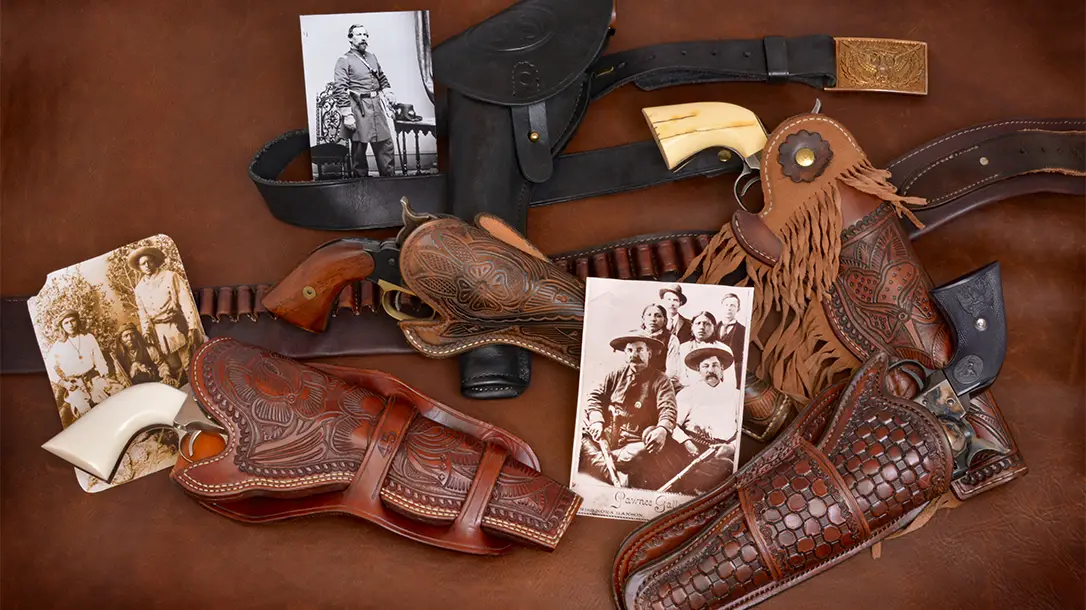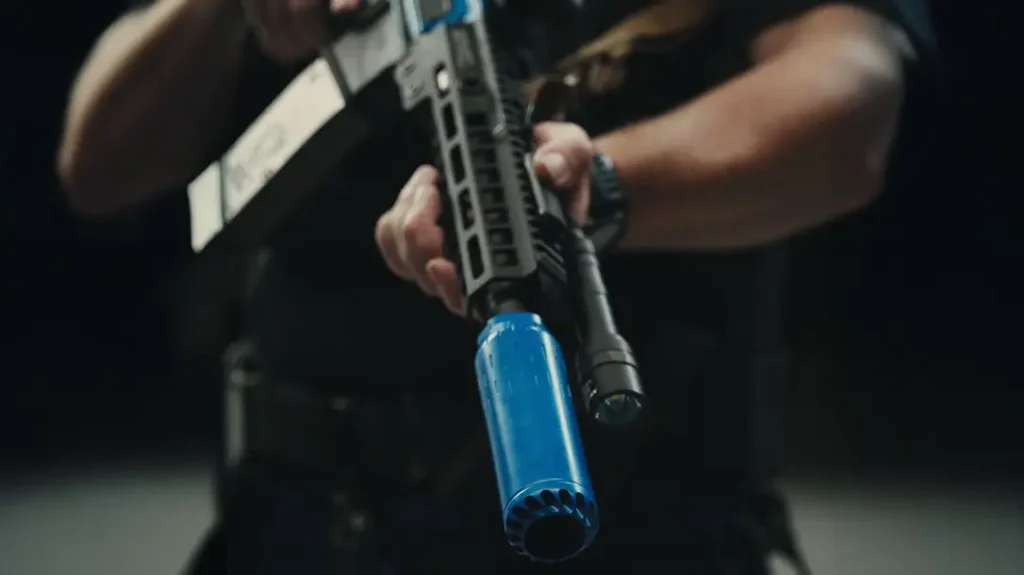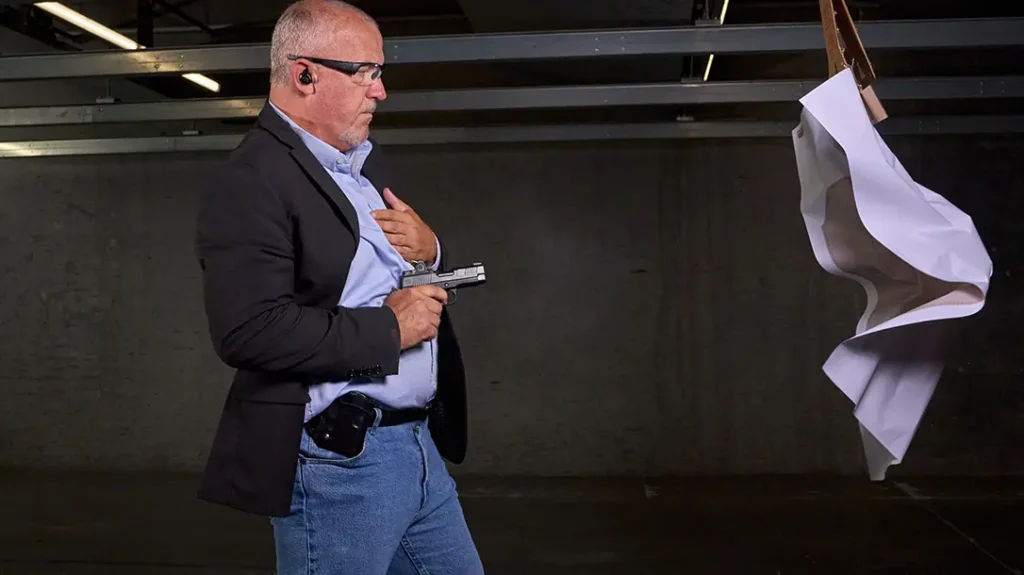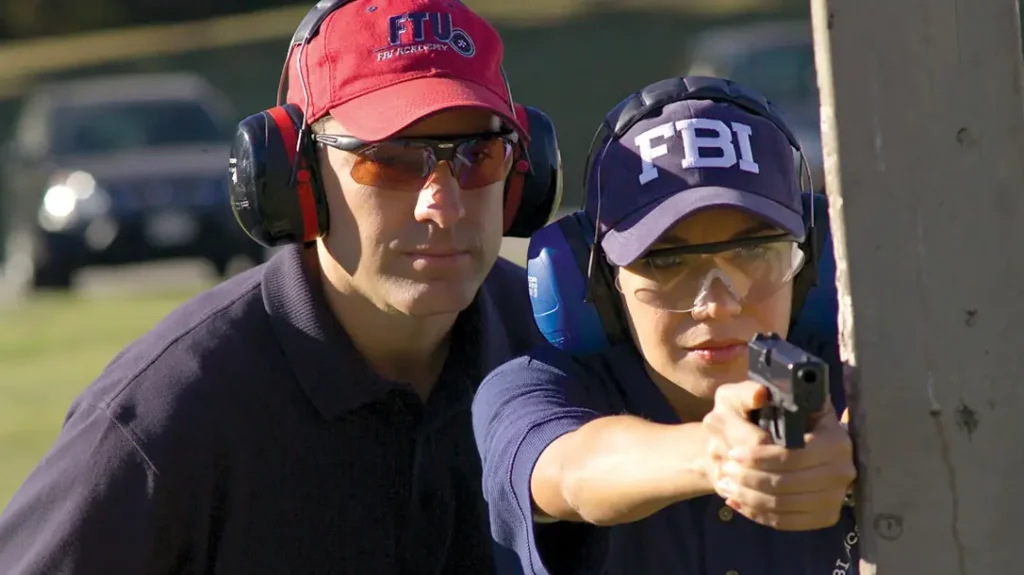Old West history has a strange interpretation of guns and holsters. Movies, as far back as the 1930s, and television shows in the 1950s and 1960s all took a great deal of license with what was period correct versus what worked better. The reasons were simple: the original guns and holsters existed, but early 20th-century Colts and Winchesters were more readily available and reliable than old 19th-century firearms. So today we ask How’s it Hanging? The facts and fiction of how gun belts were actually worn in the Old West.
How’s it Hanging? How Gun Belts Were Really Worn in The Old West
Today, historical accuracy is all but guaranteed in film and television. This is because of the abundance of fine reproductions of Old West firearms and gunleather. Some good examples are pictured above. These are a traditional Civil War-era flap holster. A hand-carved Slim Jim, an ornate fringed California Pattern holster, and two examples of the Mexican Drop Loop design. Back in the day, authenticity was more the realm of the author’s, director’s, and prop master’s whimsy. It was not only the accuracy of the guns and holsters subject to this. It was also the wardrobe department. And and even the actor’s interpretation of how they preferred to wear their guns and holsters.
The gun leather is most questionable. This is because almost every Western film and television series used Colt Single Action revolvers. They were paired with a popular 20th-century style of holster that earned the popular nickname “Buscadero. It’s an admittedly stylish gunbelt design that did not exist in the 19th century. Yet, it has become ingrained in our imaginations through film and television, and some of those holsters and their makers have become incredibly famous. Historical facts be damned!
Advertisement — Continue Reading Below

A Matter of Military Necessity
Handguns and holsters would seem to have come along at the same time. However, with the earliest practical handgun, the Wheellock, coming into use in the 1580s and early 1600s, what we regard today as a holster and gunbelt was quite different. More practical were pommel holsters (pictured below) mounted over a saddle and designed to hold one pistol on each side.

Advertisement — Continue Reading Below
Pistol belt hooks were also used, which, as the name implies, was a hook attached to one side of the frame to secure the pistol over a wide belt. Going forward, it will be easy to see where this is headed. The earliest examples of a belt holster arrived around the same time as the flintlock pistol. By the early 1700s, belt holsters began to appear, though primarily in the civilian sector. Even after Samuel Colt’s successful introduction of the revolver, pommel holsters were still favored by the U.S. Cavalry for carrying the large .44 caliber Colt Dragoons. The civilian market, on the other hand, was going in a different direction. It preferred a leather holster worn on a belt. It was a logical progression, with the basic design of the pommel holster pouch itself evolving into the design for the earliest military flap holsters in the 1850s

Civilian vs Military Holsters
As gunleather historian Richard C. Rattenbury noted in his book Packing Iron – Gunleather of the Frontier West,“Unlike military equipage. The gunleather employed by civilians in the West was not subject to imposed military standards of uniformity Rather, much early material was characterized by its diversity in form and quality. However, as early as the 1850s, isolated regional artisans were crafting and establishing new gunleather patterns better suited to frontier conditions.”
Advertisement — Continue Reading Below

Here, the holsters we most commonly recognize as “Western” were born. The “California Pattern,” perhaps one of the most prevalent from the 1850s through the 1870s, and “Mexican Loop” holsters. This style thrived from the late 1870s into the 20th century. This design is divided into single, double, and triple-loop versions and various skirt styles. It would dominate the American West we see in period photographs and in television shows and movies that are historically accurate.

Advertisement — Continue Reading Below

By the 1850s, the military had adopted the reverse draw flap holster for the Colt 1851 Navy. In early California, civilian holsters were becoming a modified version without the flap. This design came to be known as the California Slim Jim. It was a narrow, minimalist holster suitable for any number of revolvers. The Mexican Loop was a different story. Most ex-Civil War soldiers heading West carried old Colt Dragoons, 1851 and 1861 Navy and 1860 Army revolvers. They also carried Remington Army and Navy models or any six-guns built in the North and South throughout the war. They were also using their old military flap holsters. Over time, this gun leather was subjected to all kinds of weather and severe abuse. Those little belt tabs sewn on the back of the holster were becoming weak and eventually tore or simply fell off when the stitching rotted.

Advertisement — Continue Reading Below
Modifying Holsters
Westerners, of course, were always quick to adapt and make do with what they had. All it took was a sharp knife or a heavy set of shears to alter the standard military flap holster with a lost belt loop and make it into a holster. With very little work, an old flap holster could be transformed into a half-skirt “Mexican Loop” by cutting slits in the flap. Then, rolling it behind the holster and pulling the pouch through the openings. The military belt still worked perfectly with the holster flap to form the belt loop and skirt.
In the years after the Civil War, cattle became big business on both sides of the Texas/Mexico border. During this period, Mexican leather workers likely picked up on this design and began making similarly-styled rigs. The same happened at established saddlers and leather crafters in California, Colorado, Kansas, and Wyoming. Books such as Packing Iron note that the early commercial-style “Mexican Loop” holsters had only a half skirt, just like a modified military flap holster. And thus, the original, so-called “Mexican Loop” likely started out with good old American ingenuity. A poor cowboy with a need and a sharp knife. And that brings us to the burning question, “How were these holsters and cartridge belts worn?”

Advertisement — Continue Reading Below
How’s it Hanging?
In the vast majority of photographic images taken in the 1870s, holsters and cartridge belts were worn high around the waist, with most favoring the strong side draw. A lesser percentage show them worn in crossdraw style, but again high around the waist. The cross-draw position was somewhat favorable for wear on horseback, facilitating an easier draw and a more comfortable fit in the sitting position. In the photo above, “The Cowboys” from John Bianchi’s famous Histograph Series, a variety of holsters can be seen worn in traditional style. You rarely find old photos showing a gun rig slung low around the hips.


Advertisement — Continue Reading Below
Some men did wear them in that fashion, but it was still not as exaggerated as in early TV westerns and movies and nowhere as low as the famous “Buscadero” rigs, which placed the gun alongside the thigh, almost at arm’s length.

Ironically, the Buscadero rig did work well for fast draw, as proven by Arvo Ojalla and other Hollywood holster makers in the 1950s and 1960s. (His holsters, shown above, were worn by popular TV western actors.) Fast draw shootouts in the Old West were not common occurrences. Only a handful of gunmen, like Wild Bill Hickok, were capable of a fast draw from the waist. Even then, in Hickok’s most famous shootout, he took the time to rest his Colt across his left arm before firing.
Advertisement — Continue Reading Below

Old West historians are quick to note that most shootouts were escalating events, and in many cases, the guns were already drawn well before the first shots rang out. But that’s not too exciting. For the Old West tales of television and movies, the facts were better suited to the cutting room floor.

























